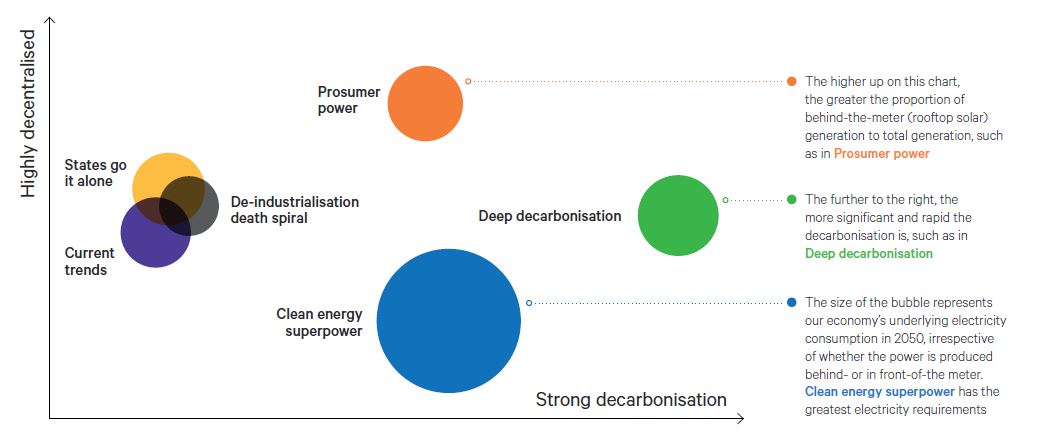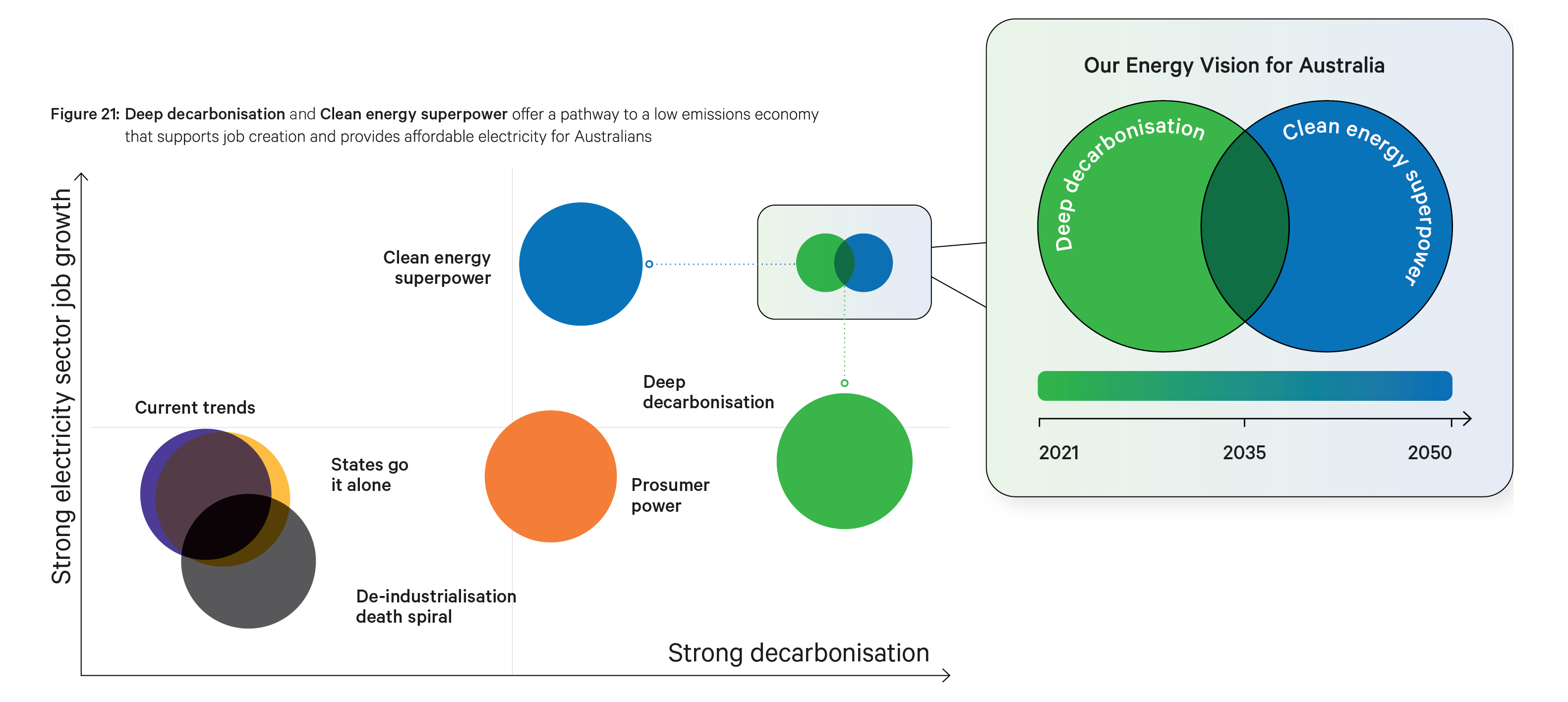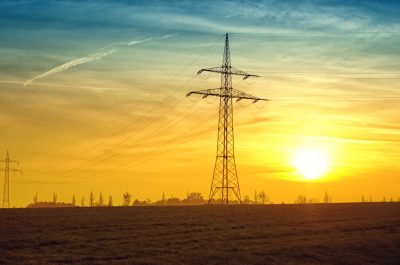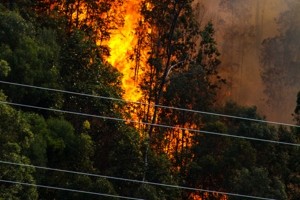Transitioning to the clean energy superpower
Australia’s energy system is undergoing a once in a-lifetime transformation. Transgrid’s Energy Vision provides evidence‑based, data‑driven insights into what that transformation could look like over the next 30 years. By planning for a diverse range of future scenarios, the energy sector can ensure Australia’s energy system is robust, resilient and flexible now and into the future.
Transgrid’s Energy Vision is underpinned by detailed scenario modelling. Transgrid partnered with independent experts, CSIRO, ClimateWorks Australia and The Brattle Group, to model the implications of a range of futures for Australia’s energy system out to 2050.
The only thing that never changes is that everything changes
Transgrid identifies six forces affecting the future of Australia’s energy system, which is shaped by technological, economic, social and political trends.
Technological advancement is occurring across all parts of the economy and the energy sector is at the forefront of this revolution.
Renewable energy technologies, batteries and storage, distributive energy resources (DER) and smart grid integration are all diving forces in the transition.
A global push towards decarbonisation has become a social and economic imperative.
While global emissions are not on track to meet the Paris Agreement targets, overwhelmingly there is a consensus that a rapid transformation is required and there are increasing community expectations to reduce our impacts on the environment.
As renewable innovation has led to significant cost reductions in renewable technologies, customers are taking more control of their preferences and the energy grid is decentralising and adapting to a two-way flow of electricity.
Consumers are expressing a desire to be more in control of their energy supply and use, enabled by distributed energy resources.
Changes to demand for electricity are inevitable. On the one hand, there is scope for a substantial growth in distributed generation and energy efficiency, which could reduce the demand for grid connected electricity industries in Australia.
On the other hand, new demand sources are emerging, which may significantly increase the need for electricity through the electrification of road transport, buildings and industry and from new electricity-intensive industries, such as green hydrogen and green metal production.
Energy market rules and regulations also remain an important driver of change and can dictate the speed with which changes can be adopted. The redesign of the National Energy Market (NEM) by the Energy Security Board (ESB) is intended to add certainty to the transformation the sector is already experiencing.
Figure 1: Six forces shaping the future of Australia’s energy system, Pg 10, Energy Vision
Six scenarios for a green future
The six scenarios Transgrid developed explore the future of the energy system using the drivers of change outlined in Figure 1. above.
These scenarios consider current trends, states going it alone, de-industrialisation death spiral, prosumer power, deep decarbonisation and Australia as a clean energy superpower.
On current trends, ageing coal power stations are replaced with competitively priced large and small‑scale renewables and storage.
In the ‘’states go it alone’’ scenario, the result is a complete breakdown of NEM regulations that sees a siloed approach from the states, which establish their own policies and local energy solutions. A regulatory impasse prevents new interstate transmission developments from proceeding.
The third scenario paints a grim future that Transgrid calls a de-industrialisation death spiral. This scenario is of a global economic downturn that causes Australia’s economic growth to slump, particularly impacting the industrial sector.
The rise of the “Prosumer” plays a role in all scenarios. The proactive-consumer drives a very high penetration of well-coordinated DER into the energy system. Rooftop solar, behind-the-meter storage and electric vehicles all mean previously passive electricity consumers are making their own choices about how their energy is produced, stored and used.
The deep decarbonisation scenario offers a holistic vision that sees market forces, international and domestic politics and consumer expectations drive a huge reduction in carbon emissions across all sectors of our economy. In this scenario, Australia commits to limit global warming to 1.5°C, in line with the aspirations of the Paris Agreement.
The final scenario sees Australia as a clean energy superpower. This scenario envisages Australia leveraging its abundant renewable energy resources and mineral ores to become a global clean energy superpower, exporting green hydrogen and metals to the world.
Scenarios are then compared against their level of decarbonisation, decentralisation and underlying electricity consumption.
Figure 2: Six scenarios for the future, Pg 15, Energy Vision
Key Trends
Transgrid then explores key trends that emerge from the scenario modelling. Some of these trends are already unfolding and form clear indicators of what a future energy sector will look like.
In all future scenarios, modelling shows an unstoppable transition to renewables and renewable energy will supply the most of Australia’s electricity production by 2050 – 94 per cent in current trends and 100 per cent in clean energy superpower. All the evidence points to the fact that the transition from a fossil fuel to a renewable energy-based power system is unstoppable.
The growth of renewables is also challenging the economic viability of Australia’s aging coal generators. Transgrid’s analysis indicates a high likelihood of early coal withdrawal across a range of future scenarios.
In all scenarios, distributed energy technologies and increasingly sophisticated consumers will play a key role in Australia’s future energy system.
There is also a critical role for behind and in front‑of-the-meter generation. Prosumer power has the highest proportion of behind‑the‑meter generation, with rooftop solar providing 27 per cent of the NEM’s electricity needs by 2050.
Electric vehicles are projected to see mass-market penetration in the coming decade. While global passenger vehicle sales dropped 16 per cent during the COVID-19 pandemic, sales of electric vehicles jumped 47 per cent. This trajectory is expected to accelerate, with falling electric vehicle costs driven by falling battery prices, dedicated electric vehicle manufacturing platforms and government support and incentives. In Europe, battery electric vehicles are expected to reach price parity with internal combustion engine vehicles between 2025 and 2027.
Surging demand for electricity in the coming decades could reshape our electricity system. Underlying electricity consumption is projected to grow more than six times to 2050 in clean energy superpower. Electricity consumption also grows significantly in prosumer power and deep decarbonisation, primarily due to the electrification of road transport and industry.
Vision for the future
Transgrid analysis indicates that the transition towards a clean energy future can create immense opportunity for Australia – if we set ourselves on the optimal course.
Transgrid’s vision is for Australia to become a global clean energy leader, benefitting communities, the economy and the environment. Transgrid’s analysis sees optimal advantage for Australia in a combination of two scenarios: first deep decarbonisation, which then morphs into Australia becoming a clean energy superpower. These two scenarios bring together the economic and climate benefits captured through embracing the energy transition and Australia’s natural advantage to become a renewable powerhouse.
Figure 3: Our energy Vision for Australia, Pg 35, Energy Vision





